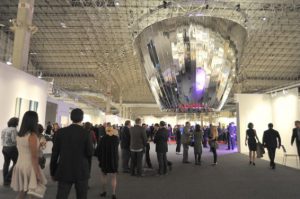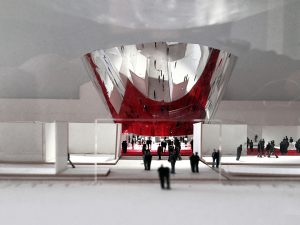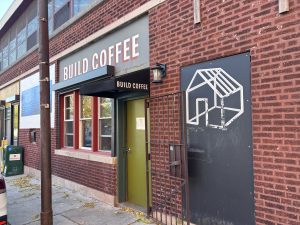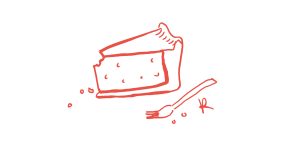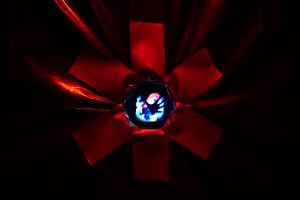![]() Robin Rios is the owner and founder of 4Art Inc. Gallery, currently located in the Zhou B Art Center in Bridgeport. I had interned at 4Art during Summer 2008 in its original Pilsen location, marking my fortuitous foray into what I had feared was the bureaucratic cult that is the art industry, only to be greeted with friendly tattooed arms, a refreshing lack of pretension, and home-grown vegetables (unpaid interns have to eat too). Robin became a mentor and a friend, and we kept in touch when I returned to New York for my senior year of college. After I graduated, she invited me back to the gallery, this time around as a curator, and gave me [relatively] free reign over such endeavors as Somnambulist, a national group show as rewarding to curate as it was to watch others try to pronounce.
Robin Rios is the owner and founder of 4Art Inc. Gallery, currently located in the Zhou B Art Center in Bridgeport. I had interned at 4Art during Summer 2008 in its original Pilsen location, marking my fortuitous foray into what I had feared was the bureaucratic cult that is the art industry, only to be greeted with friendly tattooed arms, a refreshing lack of pretension, and home-grown vegetables (unpaid interns have to eat too). Robin became a mentor and a friend, and we kept in touch when I returned to New York for my senior year of college. After I graduated, she invited me back to the gallery, this time around as a curator, and gave me [relatively] free reign over such endeavors as Somnambulist, a national group show as rewarding to curate as it was to watch others try to pronounce.
Over the past few years, I’ve spent many an afternoon picking Robin’s brain and chatting with her about art and life and our strange tolerance of piercingly cold weather. In anticipation of her next opening, we discussed her background and the many obstacles she’s faced, what it’s like to be both an artist and gallery owner, and how political and impersonal the art world can be, while at the same time how surprisingly supportive and protective artists are of each other.
4Art’s upcoming gallery opening is Friday, March 18, from 7-10pm, as part of the Zhou B Art Center’s regular 3rd Friday event.

Jenny Lam: Can you tell me a little about yourself and your background?
Robin Rios: When I think back about when I was a kid now, it didn’t dawn on me until really recently that I had always been doing art. I was sculpting different things out of clay and they actually were recognizable. In school, when I was young, I remember making ceramic bowls and stuff. I was maybe seven, and I remember I got the highest grade in the class because the teacher was real impressed that my bowls and glazing was really smooth—everybody else had bumps and cracks—and I had really intricate details on the side. My mom kept those for a long time and I guess from seven until now—I’m 42—of course they get lost because we moved a lot, but she kept them for a long time and I remember being real proud of those, even as a teenager seeing them, like, “Wow, I made that.”
And I drew, and we always had cameras. I don’t know why, but my mom and my grandparents always bought us cameras—the latest little film cameras that were out—and me and my sister had those. I remember setting out my dolls and stuff and just shooting them in a scenario, and it was funny because I just found a picture, and that’s what spawned that thinking being an artist and where that comes from.
My family was such a pusher for getting a real job that paid real money—consistently [laughter]—and having benefits, because I had health issues growing up as a kid and they wanted to make sure I had insurance and was able to take care of myself. Rightfully so. I mean, your parents want the best for you, but it just wasn’t for me; I was miserable. Art took away from the fact that I always felt stupid because of this dyslexia. I couldn’t understand why everyone else could read and spell and why that was such a horrible problem for me. So, I didn’t talk about it. I just tried to do my best, and the teachers would see that. It wasn’t like I was trying to be blatantly disruptive or trying not to do my stuff; it’s just some things I could do, and certain things I couldn’t, and I was lucky that they liked me enough to help me, that they would take time out after school to sit down with me and help me learn time tables, or take extra time outside of class to pull me aside and go over and over and over these things until I could get it. That was really helpful for me, but it didn’t make me feel any less stupid; it probably made me feel more stupid because I needed the extra help and no one else did.
But art took me away from that. When I was drawing or making sculptures or taking pictures, that just made me forget about all my life, really. But I didn’t put that all together until I saw pictures from when I was a kid, and I said, “Wow, some people would sell those photographs for 2,500 dollars today,” because that’s conceptual art, right? I had a giggle about it, because as a kid you know nothing about the art world. So that was a good revolution for me, I think. And I think that’s sort of what molded me even today as an artist.
The corporate world helps me because that helps my business side. It helps me be organized. I had to know how to talk to people. I had to understand how to absorb technical information. That really helped my brain to grow in the right direction. Dyslexia doesn’t really get in my way today. I think I grew to learn my way, and I’m not ashamed of that. I can’t pick up a manual and understand what it tells me to do; I have to look at the pictures, and then I get it. But I don’t have that shame anymore. My art has pulled me away from all of that, and I’m proud of everything that I’ve accomplished today, and as an artist, I just want people to be touched by what I do somehow.
Obviously as an artist, you don’t think so much about the financial aspect of it. Of course, you want people to buy your art, but I really say that I want the right person to buy my art, because that really means the world to me. I can’t tell you enough how many of my collectors come back to see what I’ve done next. That’s more than money to me, because they still have an interest in what I do as an artist even years later. That’s what I want to build; I want to build the relationship, that connection with people, and know that my work is going to somebody who’s going to love it for as long as they’re on the earth, and maybe their children. I don’t want just somebody to buy it because they think it’s cool or fashionable or the “in” thing today. I want to do art. I want to touch people. If it sells, great. If not, I’m still happy looking at it. [Laughter.]

But you’ve been with me for a while, and you’ve seen, you’ve absorbed, the conversations people have, the constant comments that they have about my work, and, I tell you, that’s what keeps me going. I know I’m on the right path doing what I’m doing. I can’t conveyor belt my art. I can’t do it everyday, because it has to come from that deep place. Sometimes you just have to get the business end of yourself going, and let your emotions sort of stew for a while. Then all of a sudden that great piece comes out, and you’re like, “Whoa, where the hell did that come from?” But the chessboards, I have to say, are there to be the in-between, so between the photography and the digital work, they help me to sort of fill the void in a real creative way because I don’t really have to think so much on an emotional level with the chessboards.
JL: So instead of thinking too much about it, the process simply comes to you?
RR: Yeah, I come up with an idea, I do a few sketches of how I kind of see it—the composition of it—and then I start writing down some materials that I think I might want to use. First, I go to my material toy box and start pulling stuff out, see how it looks, mashing it up, twisting it. I’ll see how the material reacts to certain things. Whatever I don’t have or need I’ll either go to Science Surplus or see what some of my friends have, and then I can recycle. If I don’t get it that way, then I’ll go to the hardware store, which is my Toys R Us, and I’ll find the rest of the supplies I need to build the boards. The boards are just a physical, intimate art source for me, but intimate on a different level—on a physical level—whereas my Observation Series, and some of the other series like the Archangel, come from a psychological and emotional place.
Sometimes, that doesn’t reveal itself to me until it’s up on the wall, and I look at it and I realize the path that piece came from. I might just have an idea vaguely, but sometimes it comes from that one single picture. All of a sudden, it helps me pull in the puzzles of the other pictures and make that collage of photos to make that one piece. It’s weird how it really comes together. It really comes from that one single image. All of a sudden, it’s almost like I know what files to go to. I need this lighting effect, I need this texture, I need this… It’s like putting together a puzzle, but you don’t really see the finished puzzle in your head, so it’s completely blind creating it. But when it’s finished, you’ve put in all this emotional effort; sometimes I get real physically tired, believe it or not. Sometimes I don’t really recognize that subconscious place, that kind of help me to sort of put this sort of thing together. Then I look at it and it’s like, “Damn, I could never tell that to people, that story.”
Art is sometimes so personal, and it’s sort of like your own therapist, and you’re putting it out there, and you’re telling your story. But when you’ve got a viewer looking at it, suddenly then they’re seeing their own story, and I like that. I like that they can come in and look at a piece and it has moved them somehow or it has awakened something or it tells something about their life or experiences or whatever it is. Once in a while, somebody asks me,” What were you feeling?” or, “What were you thinking when you created this piece?” I turn it back on them and I say, “Well, how does it make you feel?” When I get them talking about their feelings, they forget about mine.
Every once in a while, I get that one person who really wants to delve into your psyche. I had this one guy who hugged me so tight he hurt my ear, and he said, “I can tell that you had a rough life.” And, OK. But I didn’t have a rougher life than most people. I mean, my life wasn’t devastating, you know. Certainly I had my turmoils in life, but I always tried to make things better for myself in many ways. But it was funny because he was so moved by everything that he felt more than I did about it. He was the one coming in, probing me about things, and I’d be like, “Well, it’s not so much about how I feel to you as the viewer; I want to know how you feel.” The whole point of the series is to provoke you. He really wanted to get down to the nitty gritty, but he realized after a while he wasn’t going to get there with me. But I love it.

Nature, architecture, photography… definitely has always been my foremost passion, and I still love it. In fact, I think that if I wasn’t pushed in college to use my own photography for the projects, I would’ve not gotten that encouragement from one of my toughest professors. This was a lady who wouldn’t give you a kind word. She really pushed you to the brink of your sanity because she wanted you to be perfect, and I really respected her out of all my instructors because she pushed me to my limit. She wasn’t going to let you take the easy road. If it was a millimeter off, it was a millimeter off. She saw it; it didn’t matter if you didn’t see it. It’s a millimeter off. So you grew to learn that, OK, you’re going to do your projects, and none of them are going to be good, but she’s going to tell you why they’re not perfect.
So I brought in my photographs, because she had to approve everything. Everybody’s laying their photographs out on the table. I enjoyed myself that day; it was a nice sunny day and I was in Chinatown shooting some different things and I was having a good time, so I even had images in there that weren’t for the project, but they were all in the envelope. So I’m pulling them out, and she comes to my table and starts looking through things, and this was the first time she was ever speechless. Speechless, Jenny. In fact, I probably turned ten shades red. I’m thinking to myself—in my head I’m having a conversation—I spent the whole day, what do you mean you can’t find anything you like… because she didn’t say anything; she had a stone-cold face, and the only words that came out of her mouth were, “Did you take these photographs?” And I’m thinking, “Did I?” [Laughter.]
She had this sort of iron fist mentality, so you were almost scared to admit it. Well maybe I didn’t! Do you like them, because maybe I’ll say no! But I said, “Yeah, I took them,” and I was so perplexed by her actions. I didn’t really converse with her at all about it; I was just answering yes or no. She grabbed a few of them and left the room. Lady didn’t say a word to me. Am I in trouble? Did I take a picture some famous person took? Because I remember in a lot of our classes, you could get kicked out of school for plagiarizing. They beat that into our head about that kind of stuff, that you don’t claim photos that are not your own. So I got nervous, thinking, “Did someone take the same exact kind of photo?”
She came back maybe five or ten minutes later, and she said, “I had to show these to somebody who’s a photographer here at the school, because I think they’re amazing.” I think I had to sit down at that point, because she had me in such a tizzy about the whole situation, and I said, “Really?” She says, “Yeah, did you ever take photography classes before?” I said told her I hadn’t. This was a film camera I used—a Minolta, I remember—and I liked that camera. I had a couple lenses to it. It wasn’t the quickest camera—it was pretty old—but it did the trick. She said, “You know, you should really consider taking photography classes, because you really have something here. These are amazing.” Then she started looking my other photos.

I wasn’t the same after that. That day, her words… if it was anybody else, I wouldn’t have been so taken by it, but for her to tell you that you were good at something, you were good at it. She wasn’t a woman who gave compliments unless they were warranted. You had to deserve it, and I appreciated that, because I didn’t want anyone to pamper me here. I wanted to learn. I wanted to be pushed. I wanted to give my everything at that school. I never even thought I’d go to college, and here I was, and I was having a blast. Her classes were tough, but they taught me so much. What I remember out of that whole school really is that movement, because that was the beginning. There was no turning back after that. She woke something up in me that had died that had died a long time ago when I started working regular jobs and working in the corporate world, and all of that picture taking that I did as a kid came to a halt, and it just took a few words from her.
When I opened my gallery, I thanked her. In the end, because she’s an artist herself, she finally made it to the gallery before I closed over at Pilsen and moved here, and she gave me a hug and told me she was real proud of me. She almost had me in tears that day, and I told her, “That really means a lot to me that you say that, because out of everybody I respected you the most out of all my instructors.” I think that’s true for most people; if they push the hardest, you tend to respect them more. So I think about those days when I have tough times now. I think about that and I have to remind myself of my purpose, because I have one now, and being an artist means more to me than anything that money can give you. OK, so I have to wear the same shoes for a while, or clothes that might have a couple more holes than most people, but who cares? I have to make sacrifices to do something that I love. That’s what it should be about, and not how much money I can make out of that piece or this piece.
JL: Do you find in photography that you can express yourself differently from other media? What about photography draws you to that medium?
RR: Because I grew up in a not-so-great household—it was sort of unstable—I used the camera as a means to set up scenarios, as a means of getting away from my situation, as a way of creating this land or fantasy and capturing it on film. But I didn’t understand that as a kid; you just think that you’ve got a camera and you’ve got film in it and you’re going to busy yourself while everybody is acting crazy, right? You think about it as just photography.
I have this conversation with a lot of upcoming photographers, and I’ve judged twice—I’ve been invited to judge one of the oldest photography groups here in Chicago, the Fort Dearborn Photography Group—and one of the things I say is, “A flower is a flower. You, me, five other people could go and shoot the same flower, the same time of day, together, and hang them up, but it’s going to be that one photograph that gets the most attention, and it’s going to pull people in.”
Nature is, on its own, beautiful. It has its own emotion, its own life, and a camera can only capture so much of that, whereas the eye can absorb it all, in all its glory, beauty, etc. But as a photographer shooting nature, you have to have respect for it at every level, and you shoot that flower in its best, most glorious light, but some people just shoot the flower. That flower has life. It has movement. It has texture. Color. There’s so much that is so beautiful about that flower, but unless you respect that, you’ll never capture it, and even those people who can capture it, they’re only really maybe fifty, sixty percent. Nature is meant to be enjoyed in person: the smells, the feeling of the air, the breeze, watching those things physically move, touching them, feeling them… You can’t do that with a photograph. But what you can do is share your experience, and if it comes from a pure place, and you’re taking it and you’re giving that flower your best performance from your camera, people are moved by it.

Technically, that means composition. Composition of an object allows it to breathe and move on a page. That helps to bring it to life a little, because the eye moves. Obviously, the object is no longer animate, but the eye moves across the page. And there are a lot of technical things that you could throw on it: the lens on your camera. If you have to shoot from a long distance, then you have to know how to do that; if you’re going to take macro photos, getting deep down into the hairs of a plant, you have to know how to do that, to where that speaks to people from the printed page. I think photography definitely can be emotional. You have to allow it to happen.
JL: Your chessboards seem to be your trademark. How and when did you start them?
RR: It’s the chessboards and the Observation Series that I’m known for. But the boards themselves actually came through a comment through my brother-in-law. When I opened the gallery [in Pilsen], he and I used to play chess all the time by the Jumping Bean over at 18th Street, and believe me I miss that a lot, going over and hanging out, playing chess. He says to me one day, “You know, I think you should make chessboards,” and I laughed at him. I said, “Who’s going to want an art chessboard?” Master players would not play on these boards. This was my mentality, and it’s the truth; they wouldn’t, because their focus is always the game, and they don’t want pictures or anything. As a chess player, I understood the mentality and I thought, “Who the hell’s going to buy an elaborate, artsy chessboard?” He says, “How about this: I’ll give you some money for material, and you make me one for my birthday.” And I said, “Let me think about it,” because I didn’t know what to do; I’m thinking about the game and not about art and putting it together. I said, “OK, I’ll come up with an idea, and then I’ll let you know.”
I made him the chessboard, and he loved it. He was taking that board—he had that board in his car—and he was showing it to everybody. He made sure to come back to me and said, “Everybody I showed this board to said they’d buy one just like it. You need to do this. It doesn’t have to just be flat; you can think of things as sculpture.” I was intrigued by that point, hearing people’s opinion about it. I remember Kristoffer’s Café began to open up down the street, and as a designer I went to them and said, “Here’s my card; let me know if you need any graphic design. I could do your cards or your menus,” which I did do, and they still have my designs. I liked them—they were real nice people—and I said, “You know what? I’m going donate a board to them.” You go to cafés to drink coffee and play chess; that’s what I did, so I think everyone’s supposed to do that, right? So I built the board, and my brother-in-law donated and repainted some old pieces that he had that were good, heavy plastic pieces. He went and painted them with gold leaf and silver leaf to go with the board. I got so much attention for that board. People were just amazed with it.
That just kicked it off. From then on, I couldn’t make them fast enough for people. I’d have elements of boards spread across my work table, getting ready to work on bits and pieces of it. I’d have people come through and talk to me about my concept, how the end result was going to look, and put a deposit on it right then and there. It was fun.

I have to tell you, Jenny, until art came along, I really never really felt like I was good at anything. When I opened the gallery, I still didn’t feel like I was as good as some of the artist that I had in my gallery. I was in awe of most people. I couldn’t get enough of it; it was eye candy everywhere, and every time we had new artists, they’d be even better than the last, and it just kept getting better and better. When my art started selling, I was just like, “Whoa ,you picked me?” I was really humbled, because we had some top notch people. “You picked me over them? Are you crazy?” That fortified the fact that this is where I’m meant to be. This is me. This is what I’m good at.
Even today, people come in and shake my hand; sometimes people grab your hand and shake it real vigorous because they’re so excited about what you do, and I think to myself, “They don’t have to be so excited about what you do. Why should they care?” These are people you don’t really know, yet they come and thank you for doing your art, and that sort of plays with your mind a bit. You’re happy, obviously, that they are excited about what you do and it’s touched them enough that they continue to come back and see what else you do, but you kind of pay attention to how, in real life, most people don’t care about other people. So when somebody comes up to you with either such excitement or tears in your eyes, you almost don’t know how to react or act at all in that type of situation. But you think about it later, and you’re like, “Damn, that’s the most awesome thing that could happen to an artist,” and I absorb it and I thank them and there’s not enough words to say to somebody to show how much you appreciate them taking the time out to give you a comment like that.
But the chessboards are definitely something that fulfills my need to work with my hands. What’s a challenge to me is the fact that I have to think about architecture, and I have to understand in my own way how it works. Like you see this piece here [chessboard in progress pictured below]. It doesn’t look complicated to you, or to somebody else, but I had to pick the correct materials that would allow this piece to have the freedom of movement without falling over, where it would be sturdy enough yet the pieces wouldn’t fall off and you can see that it has a swagger. My brain works on a 3D level and I can see it in my mind, so although I don’t know the names of the materials, I can go to the hardware store and find exactly what I need. I’ve done enough of these now that I understand the best ways to put them together, but before, it was all trial and error, because I was just learning about materials.

Now I have a better feel, but there are certainly materials that I would love to work with that I don’t know anything about, one of them being a board that lights up, like an LED board. I would love to do one of those. That will actually be a really mentally challenging board. [Laughter.] Because it’s already been done before, I don’t want it to just be very generic, very straight-to-the-point, looking like a normal board except that it lights up. It has to be elaborate. I’ve had many people ask me how to turn these on, and there’s no turning them on. They look like they have moveable parts but they don’t. I would have people looking around like, “Where’s the switch?” “Switch for what?” They’re like, “Oh, doesn’t it turn on?” I’m like, “No!” But it’s cool that they feel like that’s dynamic enough that there’s a switch, so I feel like at some point I have to make one with a switch and it turns on. But that board will definitely take me a while.
JL: How long does it usually take you to complete a board, or do you return to it after working on other projects?
RR: Yeah that’s when the ADD sets in, because between the gallery and everything else… I mean this one’s probably 50% done. I really had to get the structural part of this board going. Now I can go back and start adding the elements that I need. The board that I carved out took me six months to just do the carving. Some people thought I should do elaborate organic-looking chess pieces, but I felt like when I do really intricate designs on a board, the pieces should really be linear and not compete with the board itself.
A lot of these boards have a good deal of recycled stuff on them. With the glass pieces sometimes I can buy them; other times I’ll still buy them, but in the summer, I go to garage sales around my neighborhood. People are just getting rid of old boards, and sometimes there’s piece missing, but I still like to get it because there might be a time when a piece breaks and I need an extra one, so those boards come in handy. I like using those recycled pieces because otherwise they’ll just go in the trash, so I don’t mind if they’re a little beat up, and obviously the buyers don’t mind either. They like the fact that you recycle some things. Some things are new, so it’s a good combination.
Other boards, when it’s mainly about the pieces, that’s when I get more elaborate. For the board that I sold before this, each piece was handmade. There were no molds; I created every piece and measured them by eye, so every piece was a little different. That was actually one of the boards that sold before I had all the pieces made, before I had the table finished, any of it. [The buyer] waited, I think, three or four months until I was complete with that board.
Now I’m working on other neo-goth type pieces. I really enjoy doing those; they kind of fall in line with the style of what I do, but the board itself will be not so elaborate because the pieces are the focus. So you’ve got to find that balance. Like with this board, the board is going to be the focus. The pieces are just going to be metal pieces, though I might do some extra things to them. I’ve got a soddering gun now; I was thinking of doing little beads of sodder on them to kind of change it up a bit, but I haven’t soddered, so that’s a new thing for me. I’ve got enough people at the center here who know how to do that, so I’ll ask for a quick tutorial. I’m excited about this board.

JL: Speaking of style, how would you describe what your style is?
RR: Wow, that’s a hard one, Jenny. [Laughter.] If you look at my boards, they sort of go all over the place. They’re all so different and one never looks like another. But if I had to like lump them up, I like complicated, complex things. I like there to be this stiffness. I like there to be this organic feeling. It comes back to my love of architecture. These boards help me feed that idea of coming up with my own designs. I like to see movement. I want to see these things almost mystically floating, in some cases. I don’t know that I can pinpoint one specific kind of style.
When I’m working on a board, I’m into that board. In fact, that board stays my favorite for a while, but they’re all my favorites, and I miss them when they leave. I’m happy that they’re going to a good home, but I honestly miss them because I will never make that same board again; I’m always moving on. My style is whatever’s in front of me. You know, I’d never carved before; that was my first carving ever, but I look forward to doing another one that would be more elaborate. But I think if I ever had to connect them with something it would definitely be for the most part architecture, because if you look at the majority of them, they’re all about lines and movement and structures. They’re not just a flat surface.
JL: Do you find that architectural quality applies to your photography and digital manipulations as well?
RR: I hadn’t thought about it that way, but now that we’re talking about it, I can see that. It’s a building up of imagery. It’s not just using this flat surface anymore; now it’s sort of building this texture, this information on a structural level. Definitely, composition is real important to me, so you see that in my pieces as well, and I think that helps to draw people in, their eye being able to follow the story in the work. So I would say so.
Read PART II of the interview here.
For more information about Robin Rios and 4Art Inc. Gallery, visit www.robinmoniquerios.com and www.4artinc.com.
Jenny Lam blogs at Artists on the Lam. Her Twitter handle is @TheJennyLam.

